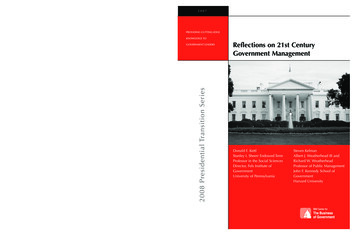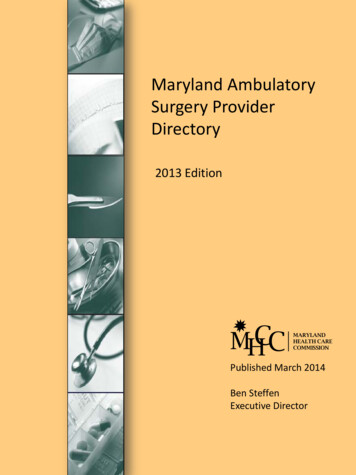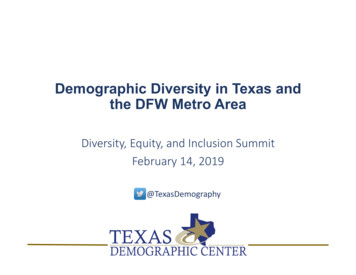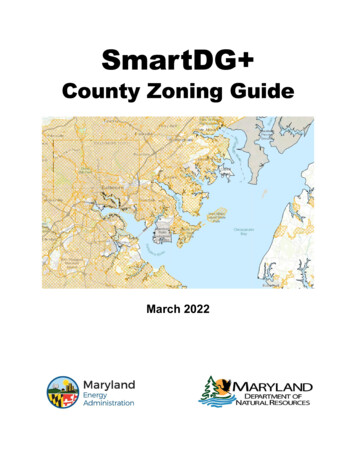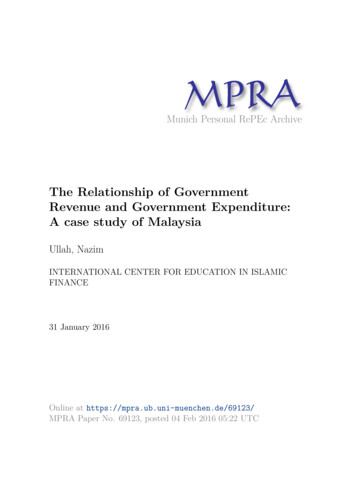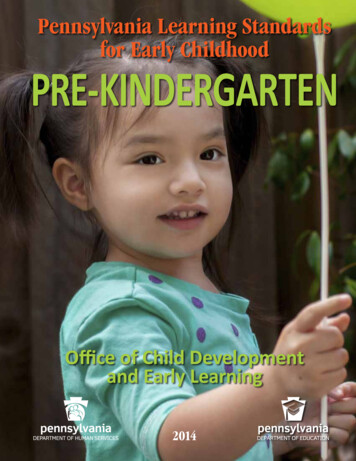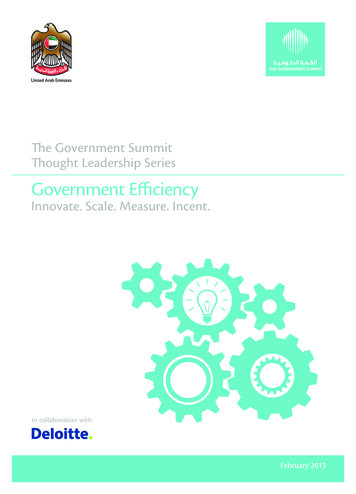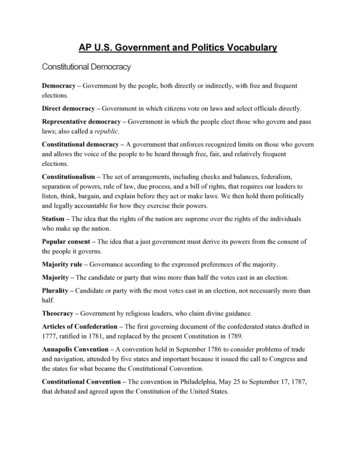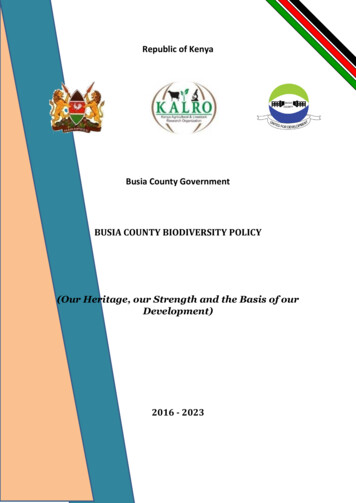
Transcription
Republic of KenyaBusia County GovernmentBUSIA COUNTY BIODIVERSITY POLICY(Our Heritage, our Strength and the Basis of ourDevelopment)2016 - 2023
Office of the County GovernorThe County Government of BusiaPrivate BagBusia, Kenya.Tel. 254-715 404040Website: www.busiacounty.go.ke Government of the Republic of Kenya, 2016
Table of ContentsForeword. iiiPreface . ivList of Terms Used in the Policy . viCHAPTER ONE: INTRODUCTION . 11.1 Background . 11.1.1 Biological Diversity . 11.1.2 Busia County . 21.1.3An overview of Biodiversity in Busia County . 31.2 Busia County Biodiversity Policy Thrust . 41.2.1 Policy Justification . 41.2.2 Policy Vision . 51.2.3 Policy Mission . 51.2.4 Policy Objectives . 51.2.5 Guiding Principles . 6CHAPTER TWO:STATUS OF BIODIVERSITY IN BUSIA . 72.1 Plant Genetic Resources . 72.2 Animal Genetic Resources . 82.3 Aquatic Genetic Resources . 102.4 Microbial Genetic Resources . 112.4 Indigenous Knowledge and Practices . 112.5 Socio-Economic Importance of Biodiversity . 112.6 Institutions Engaged In Biodiversity Conservation . 13CHAPTER THREE: POLICY ISSUES, CHALLENGES AND INTERVENTIONS ON BIODIVERSITYMANAGEMENT. 143.1 Challenges in the Management of Biodiversity . 143.2 Policy Interventions . 163.2.1Enhancing County Biodiversity Conservation . 173.2.2 Improving access to and ensuring equitable sharing of benefits accrued from utilizationof biodiversity in Busia County. . 183.2.3 Promoting Biodiversity Utilization to enhance nutrition and management of healthrelated ailments . 193.2.4 Promoting Biodiversity Research and Development . 19CHAPTER FOUR: POLICIES, STRATEGIES AND PLANS OF ACTIONS. 204.1 Enhancing County Biodiversity Conservation . 20i Page
4.2 Improving access to and ensuring equitable sharing of benefits accrued fromutilization of biodiversity in Busia County. . 254.3 Promoting Biodiversity Utilization to enhance nutrition and management of healthrelated ailments . 264.4 Promoting Biodiversity Research and Development . 26CHAPTER FIVE: POLICY IMPLEMENTATION AND REVIEW . 285.1 Institutional Framework for Policy Implementation. 285.2 Resource Mobilization . 295.3 Monitoring and Evaluation . 29ANNEXES . 31Annex I: Policy Implementation Framework. 31ii P a g e
ForewordThe people and government of Busia, especially indigenous and local communities, rely onbiodiversity for a variety of everyday purposes. We consider ourselves as custodians andprotectors of our biological diversity. As a people, the Busia biodiversity is our heritage, ourstrength and the basis of our development.In this regard we acknowledge the efforts put into the conservation, protection and wise useof biodiversity by our ancestors and forefathers. They have bequeathed us this heritage andensured that the current resources are available in this county for our continued use now andfor generations that will come after us. That biodiversity is critical for improved livelihoodsand has the potential to significantly contribute to economic and socio-cultural benefits ofcommunities and countries are indisputable.It is in recognition of the critical role that our biodiversity can play in addressing food securityof our people that the County Government partnered with the Kenya Agricultural andLivestock Research Organization, under the Biodiversity for Food and Nutrition Project, todevelop The Busia County Biodiversity Policy.Busia is a county that is very rich in genetic resources, associated traditional knowledge andvaried ecosystems. This notwithstanding, the County continues to depend on food imports,has a high prevalence of child malnutrition and high unemployment rate. To gain from theavailable rich biodiversity, the county government of Busia undertakes to promoteconservation and sustainable use of biodiversity while ensuring the fair and equitable sharingof benefits accrued from the utilization of the genetic resources.This policy is the first among many measures of enabling the Busia County Government toplay a greater role in the management of ecosystems, species and genetic diversity in amanner that is sustainable and beneficial to our people. The policy will allow for appropriatetransfer of technology to this county. It will also enable formulation and adoption oflegislation that will ensure our people and communities benefit from the rich biodiversity andassociated traditional knowledge.My government will endeavour to enhance the mainstreaming of biodiversity issues andincorporation of knowledge management systems into the county development plans,decision making processes. In addition, my government also endeavours to enhance theallocation of financial, human and material resources required to enable people to conserve,utilize and benefit from our biodiversity.The future generations expect us to leave our environment and diversity richer than we foundit. I therefore urge the key line departments that deal with natural resources to ensure theeffective implementation of this policy for the benefit of the Busia County and its people.H.E. Sospeter OjaamongGovernor of Busia Countyiii P a g e
PrefaceCountries which achieved major economic development made deliberate and strategicinvestments in conservation of their plant, animal, aquatic and microbial genetic resources,which constitutes biodiversity. More importantly, biodiversity plays a major role in theprovision of food, medicinal resources, wood products, ornamental plants, sources ofpropagation stocks and thus should be zealously conserved as its loss, some of its componentsmay not be possible to restore. Notably, indigenous knowledge and practices play a paramountrole in biodiversity conservation signifying that the Busia county community is best placed toconserve its biodiversity. Conservation of biodiversity is not only important but also part of thesustainable development goals, which advocates for secure ecosystem services andbiodiversity, ensure good management of marine and terrestrial ecosystems and naturalresources of local, regional, and global significance. It calls for the resources to be inventoriedand monitored to ensure the continuation of resilient and adaptive life support systems and tosupport sustainable development. This ensures that natural resources are managed sustainablyand transparently to support inclusive economic and human development, which is vital forproper functioning of ecosystems.Kenya being a signatory to several conventions and protocols related to Biodiversity, amongthem the Convention on Biological diversity (CBD) and its protocols, particularly the NagoyaProtocol on Access to Genetic Resources and the Fair and Equitable Sharing of BenefitsArising from their Utilization (ABS), conservation of biodiversity is not optional and thusBusia county takes a lead in conserving its biodiversity. This is because under the devolutiongovernance initiative in Kenya, it is the mandate of each.This policy addresses management of ecosystem, species and genetic diversity. Themanagement will comprise: in-situ and ex-situ conservation of biodiversity, appropriatemeasures for access and sustainable use, appropriate mechanisms for the transfer of relevanttechnologies including biotechnology, protection of intellectual property rights over accessedgenetic resources and associated knowledge, and provision of appropriate fundingmechanisms. It endeavours to provide Busia County with a framework for biodiversityconservation, protection and promotion of sustainable use of genetic resources and associatedtraditional knowledge including cultural expressions, and equitable sharing of benefits accruedfrom this use. It will enhance mainstreaming of biodiversity issues and knowledge managementsystems into the County’s development plans and decision making processes. Features in thisiv P a g e
policy is the diverse biodiversity and the communities’ rich cultural heritage. These includeand are not limited to traditional literature, arts and crafts, music, visual arts, ceremonies,beliefs, architecture, knowledge related to traditional-medicines and practices, agriculture andforestIt is our hope that implementation of this policy will serve not only current but also futuregenerations.Hon. Dr. Moses Osia MwanjeCounty Executive Committee Member for Agriculture and Animal ResourcesBusia Countyv Page
List of Terms Used in the PolicyAccess: in relation to genetic resources, includes the collection, use and exploitation of thoseresources.Access and benefit-sharing: refers to the way in which genetic resources may be accessed, andhow users and providers reach agreement on the fair and equitable sharing of the benefits thatmight result from their use.Associated traditional knowledge: knowledge which is dynamic and evolving, generated in atraditional context, collectively preserved and transmitted from generation to generationincluding but is not limited to knowhow, skills, innovations, practices and learning, that [subsistin] [that are associated with] genetic resources.Biodiversity: Refers to the variability that exists among living organisms from all sourcesincluding among other things, terrestrial, marine and other aquatic ecosystems and the ecologicalcomplexes which they are part of. This includes diversity within species, between species andtheir ecosystems.Biological resources: Includes genetic resources, organisms or parts thereof, populations, or anyother biotic component of ecosystems with actual or potential use or value for humanity.Biopiracy: the unethical or unlawful appropriation or commercial exploitation of biologicalmaterials (such as medicinal plant extracts) that are native to a particular country or territorywithout providing fair financial compensation to the people or government of that country orterritoryBioprospecting: any research on, or development or application of, indigenous biologicalresources for commercial or industrial exploitation, and includes the systematic search, collectionor gathering of such resources or making extractions from such resources.Ex-situ conservation: is the conservation of components of biological diversity outside theirnatural habitats.Genetic material: any material of plant, animal, microbial or other origin containing functionalunits of heredity.Genetic resources: genetic material of actual or potential value.In-situ conditions: are conditions where genetic resources exist within ecosystems and naturalhabitats, and, in the case of domesticated or cultivated species, in the surroundings where theyhave developed their distinctive properties.Misappropriation: is the acquisition/utilization of genetic resources, their derivatives and/orassociated traditional knowledge/traditional knowledge associated with genetic resourceswithout the free/prior informed consent of those who are authorized to give such consent to suchvi P a g e
acquisition/utilization, in accordance with national legislation of the country of origin orproviding country.Traditional knowledge in the context of access and benefit-sharing refers to the knowledge,innovations and practices of indigenous and local communities (ILCs) related to geneticresources. This traditional knowledge is developed through the experiences of communities overcenturies, adapted to local needs, cultures and environments and passed down from generationto generation.Traditional knowledge associated with genetic resources: any knowledge or innovation inrelation to genetic resources and their use that constitute part of the common, traditional orcustomary patrimony of indigenous peoples and local communities.Utilization: of Genetic Resources means to conduct research and development includingcommercialization on the genetic and/or biochemical composition of genetic resources, theirderivatives and associated traditional knowledge/traditional knowledge associated with geneticresources including through the application of biotechnology as defined in Article 2 of theConvention on Biological Diversity.vii P a g e
CHAPTER ONE: INTRODUCTION1.1 Background1.1.1 Biological DiversityBiodiversity or biological diversity is the variability among living organisms from allsources including, inter alia, terrestrial, marine and other aquatic systems and theecological complexes of which they are part. Biodiversity encompasses all variety of lifeforms at all levels of biological systems (i.e., genetic/molecular, species, organisms,population, and ecosystems). It includes diversity within species, between species andassociated ecosystems.The significance and contribution of biodiversity to improved human livelihoods andwell-being has increasingly gained prominence and become clearer over the last fewdecades. The benefits that humans receive from the resources and the natural ecosystemservices thereof (the ‘ecosystem services’ concept), can be measured based on differentparameters one of which is the Millennium Ecosystem Assessment (MA 2005) that usesfive different categories of ecosystem services:(i)Provisioning services such as food, water, timber, and fibre;(ii) Regulating services that affect climate, floods, disease, wastes, and water quality;(iii) Cultural services that provide recreational, aesthetic, and spiritual benefits; and(iv) Supporting services such as soil formation, photosynthesis, and nutrient cycling(v)Supporting science, research and education such as providing the geneticmaterial by which breeders seek to isolate and improve plant varieties, animalbreeds and greater understanding of nature.Biodiversity is therefore critical for improved livelihood and has the potential, if properlymanaged, to significantly contribute to economic and socio-cultural benefits ofcommunities and nations. In particular, the ability to use biodiversity to address globaland national food security is immense. The link, for example, between genetic diversityand sustainable agriculture include ability to use genetic diversity as a basis for breedingof new crop varieties to meet a society’s agricultural food and agricultural raw materialneeds and to deploy genetic variation in plant populations to reduce risk and increaseoverall production stability. In addition, biodiversity offers opportunities for diversifyingfood sources beyond the traditional crops and animals used by man for food.The following three areas have been determined to be critical to the proper managementof biodiversity;(i)Conservation of biodiversity(ii) Sustainable use of biodiversity components1 Page
(iii) Fair and equitable sharing of benefits arising out of the utilization of geneticresourcesCountries are interdependent to the extent that biodiversity is a common global heritage.Their benefits go beyond a country’s borders, thus making their management a commonconcern of all countries. Enabling policy environment at national, regional andinternational levels is necessary for effective conservation, access and utilization ofbiodiversity including equitable sharing of benefits accruing thereof. It is with thisrecognition that a multiplicity of international legal instruments have been put in placeto guide nations in in this endeavour. The instruments include the Convention onBiological Diversity (CBD), International Treaty on Plant Genetic Resources for Food andAgriculture (ITPGRFA), Nagoya Protocol, the Cartagena Protocol, the InternationalConvention for the Protection of New Varieties of Plants (UPOV), the World TradeOrganizations – Agreement on Trade Related Aspects of Intellectual Property Rights(WTO-TRIPS), Biological, Toxin and Weapons Convention (BTWC), the Convention onInternational Trade in Endangered Species of Wild Fauna and Flora (CITES), the WorldConservation Union (IUCN), United Nations Framework Convention on Climate Changeand the Convention on Wetlands of International Importance (RAMSAR Convention).Kenya is a signatory to the above legal instruments and implements their provisionsthrough various government-led agencies. These agencies include the NationalEnvironment Management Authority (NEMA), Kenya Wildlife Service (KWS), NationalMuseums of Kenya (NMK), Kenya Forest Service (KFS), the Genetic Resources ResearchInstitute (GeRRI), National Biosafety Authority (NBA), Kenya Plant Health InspectorateServices (KEPHIS), Kenya Industrial Property Institute (KIPI) and National Commissionfor Science Technology and Innovation (NACOSTI). Part of the responsibilities of theselead agencies established under different legislations is the proper management ofKenya’s biodiversity through effective conservation, utilization and sharing of benefits.1.1.2 Busia CountyBusia County is located on the western end of Kenya, bordering Uganda and covers anarea of 1,694.5 Km2. The County has seven sub-counties, 35 Wards, 60 locations and 181sub-locations. Most parts of Busia County fall within the Lake Victoria Basin. The altitudeis undulating and rises from about 1,130m above sea level o the shores of Lake Victoriato a maximum of about 1,500m in the Samia and North Teso Hills. The county is alsoserved by rivers Malakisi to the extreme north, Malaba in the northern entry of the centralregion and River Sio in Funyula and Nambale Sub-counties. River Nzoia drains into LakeVictoria through Budalang’i Sub-county.2 Page
Fig. 1: Busia County Location and Administrative Units1.1.3 An overview of Biodiversity in Busia CountyCrops, livestock and fish production constitute the main economic activities of the peopleof Busia County. These are mainly carried out at subsistence level for local consumption,and only minimal for commercial purpose. The main type of crops grown in Busia Countyinclude: maize, cassava, finger millet, beans, sorghum, rice, sweet potato, cowpea,groundnuts, banana, green gram, sesame, soya beans, cotton, tobacco, sugarcane, oilpalm, and pepper. There are also horticultural crops including pineapples, tomatoes,kales, cabbages, water melons, local vegetables, papaya, jack fruit, amaranth, onions and,mangoes, among others.The main livestock in the county are zebu cattle, sheep, goats, pigs and free-range localchicken. Fish capture from Lake Victoria is the main fishing activity in the Budalang’i andFunyula Sub-counties. In addition, there is fish farming in the County with about 1500fish ponds spread across the Sub-counties, where Tilapia and mud fish species are beingfarmed.Busia County has a natural forest covering the hills of Samia and Budalang’i while otherparts of the county have on-farm woodlots that have been integrated with agriculturalfarming. The County has two gazetted replanted forests mainly located in Budalang’i subcounty with an area of 528.8 Ha. The main forest products from the two types of forestsinclude firewood and charcoal as fuel, medicinal plants, honey for commercial anddomestic consumption, and timber for construction of houses. The commercial forestsproduce poles for sale to the Kenya Power Company; among others. These ForestEcosystems provide goods in form of fruits, edible roots, tubers, berries, medicinalherbs/leaves, timber, firewood and fodder to both humans and animals. They also3 Page
provide ecosystem services such as pollination, absorption of CO2 and nutrient recycling.Forests are also recipients and partial recyclers of waste products from the environment,in addition to being a source of recreation, beauty, spiritual values and other culturalamenities.1.2 Busia County Biodiversity Policy Thrust1.2.1 Policy JustificationKenya is a signatory to several conventions and protocols related to Biodiversity, towhich Busia County is also bound. Key among them is the Convention on Biologicaldiversity (CBD), and its protocols, particularly the Nagoya Protocol on Access to GeneticResources and the Fair and Equitable Sharing of Benefits Arising from their Utilization(ABS). The objectives of the CBD are the conservation of biological diversity, sustainableuse of its components and the fair and equitable sharing of benefits arising from itsutilization. The provisions of both the CBD and Nagoya Protocol are stipulated in theNEMA Legal Notice No. 160 of 2006 that governs the ABS; in addition, Kenya is also partyto the FAO International Treaty on Plant Genetic Resources for Food and Agriculture(ITPGRFA). The Treaty provides facilitated access to genetic materials of globalimportance in food security. It also provides for protection of farmers’ rights to use andexchange farm-saved seed. Biodiversity issues are very pertinent in trade and commerce,as envisaged in the Agreement on Trade Related aspects of Intellectual Property Rights,also known as TRIPS, to which Kenya is a party, and by extension Busia County as well.The Constitution of Kenya 2010, in its Articles 11 on Culture, and 69 on Environment,among other relevant articles, provides an opportunity to mainstream issues related toculture, biodiversity and protection of communal and individual intellectual propertyrights in regard to planning for sustainable development. These issues are similarlypertinent to Busia as a County.In regard to biodiversity in Busia County, the issue to be addressed by this policy is themanagement of ecosystem, species and genetic diversity. The management will comprise:in-situ and ex-situ conservation of biodiversity, appropriate measures for access andsustainable use, appropriate mechanisms for the transfer of relevant technologiesincluding biotechnology, protection of intellectual property rights over accessed geneticresources and associated knowledge, and provision of appropriate funding mechanisms.Busia County has diverse biodiversity and the communities have a very rich culturalheritage. These include traditional literature, arts and crafts, music, visual arts,ceremonies, traditional beliefs, traditional architecture associated with particularcommunities and sites. The rich culture also includes forms of traditional knowledgerelated to traditional-medicines and traditional-medical practices, agriculture and forestmanagement practices. These interactions between man with the biotic and abioticenvironment has resulted in beneficial cultural practices which for generations hassupported livelihoods of the Busia County communities.4 Page
We are cognisant that communities possess their own locally-specific systems ofjurisprudence. The systems are in respect to classification of different types ofknowledge, proper procedures for acquiring and sharing knowledge and the rights andresponsibilities attached to possessing knowledge. All these are embedded uniquely ineach community and the ecosystem surrounding it.It has also been observed that scientific and technological advances based on traditionalknowledge and sound traditional understanding and management of biodiversity is onthe rise. However, aspects of this advancement are being disseminated and commerciallyexploited without due recognition of the original owners of knowledge and ensuringequitable sharing of benefits thereof.This Policy endeavours to provide a Busia County framework for biodiversityconservation, protection and promotion of sustainable use of genetic resources andassociated traditional knowledge including cultural expressions, and equitable sharing ofbenefits accrued from this use. The Policy will enhance mainstreaming of biodiversityissues and knowledge management systems into the County’s development plans anddecision making processes.1.2.2 Policy VisionA rich and stable ecosystem providing benefits for all in Busia County.1.2.3 Policy MissionTo restore and manage biodiversity, through community empowerment, and inclusiveapproaches.1.2.4 Policy Objectives(i) Overall Policy ObjectiveManagement of Busia County biodiversity for sustainable development andimproved livelihoods.(ii) Specific Policy Objectives1.To promote effective conservation and facilitate structured access tobiodiversity resources and associated ecosystems.2.Ensure equitable sharing of benefits accrued from utilization of biodiversity inBusia County3.Enhance sustainable utilization of biodiversity for improved nutrition andlivelihoods in Busia County.4.Mainstreaming biodiversity research in county development planning andimplementation in Busia County5 Page
1.2.5 Guiding Principles1.We shall observe and respect international and national frameworks that guidethe management of biodiversity.2.Uphold county priorities as we endeavour to meet national obligations.3.Encourage exploitation of local biodiversity resource within Busia.4.Collaboration and partnerships that promote inclusivity and public participation.5.Adhere to principles and practices of biosafety in the utilization of biologicaldiversity.6.Equitability in the sharing of benefits arising/accruing from utilization ofbiodiversity6 Page
CHAPTER TWO: STATUS OF BIODIVERSITY IN BUSIABiodiversity is the variety of life on earth. It is the variability among living organisms fromall sources including, inter alia, terrestrial, marine and other aquatic ecosystems and theecological complexes of which they are part; this includes diversity within species,between species and of ecosystems.Busia is endowed with a diverse heritage of plant and animal genetic resources. Thesecomprise of agricultural biological diversity, or agro-biodiversity, an essentialcomponent of biological diversity. Agro-biodiversity is necessary in sustaining keyfunctions of any agro-ecosystem, its structure and processes. Agro-biodiversity supportsfood production, food and nutrition security and economic development initiatives. Thevarious species of plants, animals, and microorganisms, constitute the enormous geneticdiversity found in different ecosystems of Busia County. The ecosystems include:wetlands, farmlands, forests (natural and artificial), lake, rivers, streams, hills and valleybottoms. Cultures of the Busia people have their roots in this diversity in the form of food,traditional beliefs, housing and livelihoods sources. In addition, the rich diversity hasbeen used for medical purposes, economic development, and adaptive responses to newchallenges such as climate change.2.1 Plant Genetic ResourcesBu
available rich biodiversity, the county government of Busia undertakes to promote conservation and sustainable use of biodiversity while ensuring the fair and equitable sharing of benefits accrued from the utilization of the genetic resources. This policy is the first among many measures of enabling the Busia County Government to


